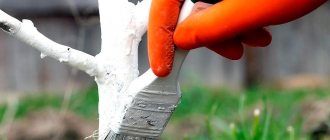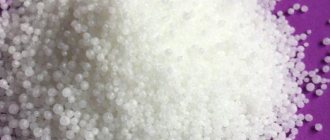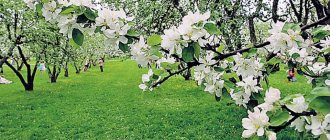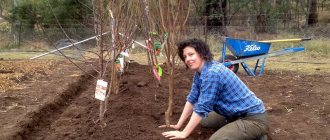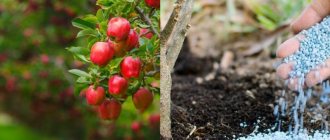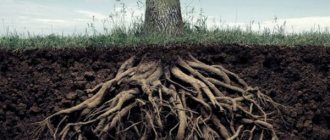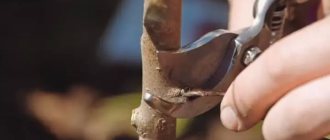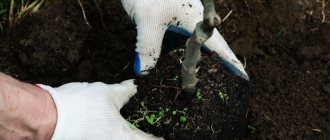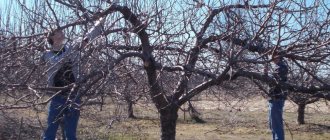Spraying apple trees with urea in the fall. Urea
Urea (urea) is carbonic acid diamide, colorless or white crystals, soluble in water.
In agriculture, it is primarily a supplier of nitrogen. Urea has high chemical activity and is well absorbed by plants during processing. Urea in high concentration can be used to protect trees from diseases and pests. Apple trees need to be treated in early spring and autumn, after leaf fall. A concentrated solution applied during the growing season will burn the leaves. For foliar feeding, urea is used by diluting a small amount of the drug in water.
Treating apple trees with urea in the fall will help:
- in the fight against diseases and pests;
- to treat fallen leaves against larvae of pests and pathogens overwintering in them;
- increase the winter hardiness of the apple tree;
- to slow down the start of the growing season.
Fallen leaves are processed in the fall when they are not removed from the site for one reason or another. Then the solution is made with a concentration of at least 10% and sprayed generously, turning the litter from time to time with a pitchfork or rake. Urea will simply burn the larvae and spores of diseases, and by spring the leaves will rot and become additional fertilizer for the apple tree.
Treatment with urea will help in the destruction of pests of apple trees and other fruit crops:
- aphids;
- weevil;
- copperheads;
- apple blossom beetle.
Using urea treatment you can fight diseases:
- monilial burn;
- scab;
- purple spotting.
You can treat an apple tree that has lost 70% of its leaves. In this case, the concentration of the working solution should be within 5-7%. But it is better to treat in late autumn, when the apple tree has completely shed its leaves. Then you can spray the tree, tree trunk and fallen leaves with a 10% urea solution (which will be more effective).
Important! Young apple trees under 5 years of age must be treated with a 5% solution.
Before spraying in the fall, you need to prune, it is advisable to remove plant debris. If necessary, strip the bark from old trees.
It is necessary to treat apple trees in the fall against pests and diseases in calm weather, on a cloudy day at a temperature of at least 5⁰ C.
Important! You cannot combine urea with chalk and lime.
The need for feeding
An apple tree can grow in one area of an orchard for several thousand years. Accordingly, the soil on which it grows is depleted over time, which leads to a deterioration in yield and fruit quality. Therefore, apple trees must be fed, especially during the growing season.
Fertilizing apple trees in spring with urea
Feeding fruit trees in the spring is an important condition for a bountiful and healthy harvest. With the onset of warm days, experienced gardeners begin to prepare fertilizers for complete and healthy nutrition of apple trees.
It is usually recommended to start feeding trees with fertilizers after three years from the date of planting the seedling. The soil is fertilized several times a year:
- Before flowering. It is carried out at the beginning of the growing season. The root system is fed. For this purpose, nitrogen-containing fertilizers are most suitable;
- During the flowering period. Feeding begins when the flower clusters begin to bloom. It is important to have time to fertilize at the beginning of budding. Only the root is fed;
- After flowering. Occurs during fruit filling.
Important! After the amount of nutrients is replenished, the apple tree’s yield will increase and its disease resistance will improve.
Spraying with urea and copper sulfate in the fall. Chemicals for treating trees
Plant treatment products are divided depending on the type of insect:
- attractants;
- sterilizers;
- aficides;
- pheromones;
- affidants;
- repellents;
- insectoacaricides;
- ovicides;
- larvicides.
The choice should be based on the mechanism of action of the drugs, since some do not have a detrimental effect on eggs or are not effective against adult pests.
Experienced gardeners use the following preparations to treat the garden:
- Karbofos - against fruit mites, copperheads, psyllids, moths;
- Avant - from the codling moth and leaf roller;
- Apollo - against fruit mites;
- Agravetrin - from moths, aphids, sawflies, codling moths;
- Karate - against gall mites.
Every year, store shelves are filled with new products to combat garden pests, so the problem is relevant and requires a safe solution.
More than one generation of gardeners has used copper and iron sulfate, urea, and lime treatment in the fall, which allows them to obtain a full, high-quality harvest.
Let's celebrate! It is important not to neglect garden care and carry out treatments in a timely manner in order to see lush flowering in the spring and collect juicy fruits in the summer.
Spraying fruit trees in the fall in the current conditions, when a whole bunch of diseases are raging in the gardens, is not at all new to experienced summer residents. But Bordeaux mixture and urea are no longer effective. And they are too toxic. Therefore, it is necessary to select safer drugs that give, if not immediate, then more sustainable results. We share our experience on how and how to spray the garden in autumn, how to clean the bark of fruit trees and how to whiten the trunks.
Timing of work
Most plant care activities occur in the spring, before the growing season begins. They are necessary to protect against fungal infection and destroy parasites that survived after wintering. Autumn treatment is used to prevent the development of diseases and the proliferation of insects that hide in the foliage or in the cracks of the bark.
Often, novice gardeners make a serious mistake - they spray at the very beginning of autumn. As a result, leaves fall earlier than usual. Burns appear on the trunk, reducing the trees' resistance to frost. The optimal processing period is late October - early November.
The procedure is carried out at positive temperatures, in dry weather, without wind. It is better to spray apple trees in the morning or evening, after sunset. If precipitation is observed on the same day, the treatment must be repeated. Otherwise, all the beneficial substances will be washed away, and the apple tree will be left without protection from diseases and parasites.
It is permissible to carry out the procedure after the first frost. Do not get carried away with excessive spraying of plants. Excess chemical components can harm them rather than benefit them.
Treating roses with urea in the fall. 1 What is urea and how to use it?
Urea (otherwise known as urea) is a nitrogen fertilizer with a high nitrogen content (concentration) - up to 46%. Urea is produced in the form of white-yellow granules.
It is odorless and completely soluble, especially quickly if diluted in heated water. Urea strongly absorbs moisture even from the air, so it requires storage in an airtight container.
This fertilizer is able to be evenly distributed over the soil of the land plot; it is well absorbed by most plants. The latter quality is important for trees in terms of their resistance to harmful insects. When using urea, remember these features:
- At the same time it is an organic compound and a mineral fertilizer;
- Its action begins instantly and lasts for a long time;
- When fertilizing the garden, apply it directly to the soil due to the risk of weathering;
- You can use it for open areas and protected soil (greenhouses, greenhouses, hotbeds);
- Its effective effect on plants in soils with high moisture content has been confirmed;
- In acidic soils, there is less loss of nitrogenous substances by urea (compared to alkaline and neutral soils);
- Once in the ground, it turns into ammonium urea;
- One of the safest and most effective summer garden fertilizers, even if the dose is exceeded, it will not burn the trees;
- Treating trees with urea prolongs their growing season and makes them bloom later. Frosts in early spring are dangerous for the ovaries and shoots of stone fruit crops (peaches, cherry plums, plums and apricots);
- When spraying trees on the buds, it increases their resistance to diseases/harmful insects;
- Promotes rapid decomposition of stump residues;
- It is forbidden to mix urea with ordinary lime, chalk and simple phosphorus fertilizers.
A mixture of urea and iron sulfate. Solutions for autumn garden treatment
Various preparations are used to spray bushes and trees in the garden. Each of them fights specific pests. Along the way, some help increase the harvest in the future.
The main tools used for processing skeletal branches and trunks:
- urea, a nitrogen fertilizer that destroys insects and arthropods, has a detrimental effect on fungal spores;
- Copper sulfate is a universal fungicide. Pathogenic microflora in the presence of this substance stops development completely;
- iron sulfate is an analogue of copper sulfate, but has another selective effect, destroying a number of types of mold that survive treatment with other fungicides;
- Bordeaux mixture is a complex of different drugs used to protect plants.
You can use any one drug, but it is more effective to create a working mixture of several drugs. Then, with a single treatment, a greater effect is achieved.
Urea (urea)
Urea with (NH₂)₂CO contains up to 46% of assimilable nitrogen, which is one of the three most important preparations for all types of plants. Use solutions with a concentration of 5...7%, preparation: 10 liters of water are diluted with 500...70 g of urea.
(NH₂)₂CO burns away fungal spores, as well as insects and caterpillar eggs. In addition to fertilizing the garden, complete disinfection of the garden is achieved.
In addition to the crown, tree trunk circles are processed. In the spring, the effect of the treatment is manifested, the shoots grow quite quickly in the spring, shrubs and trees quickly put on leaves.
Copper sulfate
CuSO₄ - copper sulfate is used for prevention in the garden and vegetable garden, as well as to destroy putrefactive bacteria. It is detrimental to the pathogenic environment. Treatment with this drug helps get rid of fungal diseases and dangerous types of mold.
In the garden in the fall it is most often used in the form of a one percent solution; for preparation, 100 g of the substance is diluted in 10 liters.
inkstone
Iron sulfate is an antiseptic that inhibits rot, mold and fungal infections. Along the way, it is a fertilizer that provides plants with iron.
With a lack of iron, the leaves begin to turn yellow and the shoots die. Fruit trees (pears, apples, cherries and others) need annual fertilizing in the form of iron sulfate. The treatment will also be useful in the garden; iron sulfate Fe₃ (SO₄)₂ is useful for tomatoes, cabbage, and potatoes.
To remove lichens and moss, treatment with a five percent solution is required. 500 g of Fe₃ (SO₄)₂ are diluted in 10 liters of water. Mix thoroughly until completely dissolved.
Bordeaux liquid
Bordeaux mixture is sold in the form of concentrates. It is effective against many pests. The composition includes: copper sulfate and slaked lime. Spraying such a solution is more difficult. Lime is a colloidal solution that has suspended particles. Therefore, the spray is adjusted so that the nozzles do not become clogged.
Is it possible to mix iron sulfate and urea? Preparations for spraying fruit trees
There are quite a few different drugs that are used to treat fruit trees against pests and diseases. These include the following:
- carbamide (urea) solution;
- Bordeaux mixture;
- copper sulfate solution;
- iron sulfate solution;
- mineral fertilizer solution;
- other fungicides and insecticides.
Urea (urea) is a fairly common water-soluble ammonia fertilizer. To prepare a solution for spraying, you need to dilute 0.4-0.5 kg of the substance in a bucket of water (10 l). Spraying with urea is effective against scab pathogens.
Tree trunk circles are also treated with a solution of high concentration (7-8%), destroying pests overwintering there. However, you need to make sure that such a solution does not get on the tree bark, otherwise the plant will receive a chemical burn.
Iron sulfate is widely used in gardening as a means of combating and preventing diseases such as scab, powdery mildew, fruit rot (monoliosis), black cancer and others. It is also a very effective remedy against various mosses and lichens that parasitize the bark of fruit trees.
Iron sulfate is a water-soluble compound. To prepare the solution, you need to take 200-300 g of the product per 1 bucket of water; if the trees suffered from any disease during the season, the proportion of vitriol can be increased to 400 g.
Preparations containing copper have long been successfully used to protect plants by gardeners around the world. One of these products is copper sulfate, a widely known substance used both as a microfertilizer and as a broad-spectrum fungicide (antifungal agent).
To prepare a solution for spraying, mix 100 g of copper sulfate and 10 liters of water. If diseases were noted on the plants during the season, then you need to take 300 g of vitriol. The substance dissolves well in water, giving it a characteristic blue color.
In addition to urea, copper and iron sulfate in their pure form, their combinations with each other are also used. For example, a good result is obtained by using iron sulfate mixed with urea (200 g of each drug per 1 bucket of water).
There are other preparations that can be used in the fall to spray fruit trees against diseases. These include the well-known Bordeaux mixture, which is copper sulfate in combination with quicklime.
- copper sulfate – 300 g;
- quicklime – 400 g.
Each component is dissolved in 5 liters of water. Then the copper sulfate solution is carefully added to the lime solution, taking precautions and stirring constantly.
If fruit and berry trees have not been sick during the year, the concentration of the solution can be reduced to 1%. To do this, you will need to reduce the content of all ingredients by 3 times. The procedure for preparing Bordeaux mixture remains unchanged.
For autumn treatment of the garden against pests, you can also use insecticides, for example, Fufanon or Preparation 30 Plus. These are quite effective means, but only autumn treatment will not give the desired result.
Precautionary measures
When using urea, precautions must be taken. Before you begin preparing the solution or processing, you should put on gloves, goggles and a protective mask. During the procedure it is forbidden to drink, smoke or eat. If the drug enters the digestive tract, it can cause poisoning. In this case, the person feels nausea, general weakness, and suffocation. When these signs appear, it is necessary to rinse your mouth and provide access to fresh air. If your health worsens further, you should consult a doctor.
If, when working with urea, the solution gets on the skin or mucous membranes, it is necessary to immediately rinse with a stream of water. At the end of feeding, you need to take a shower with soap and wash your clothes.
